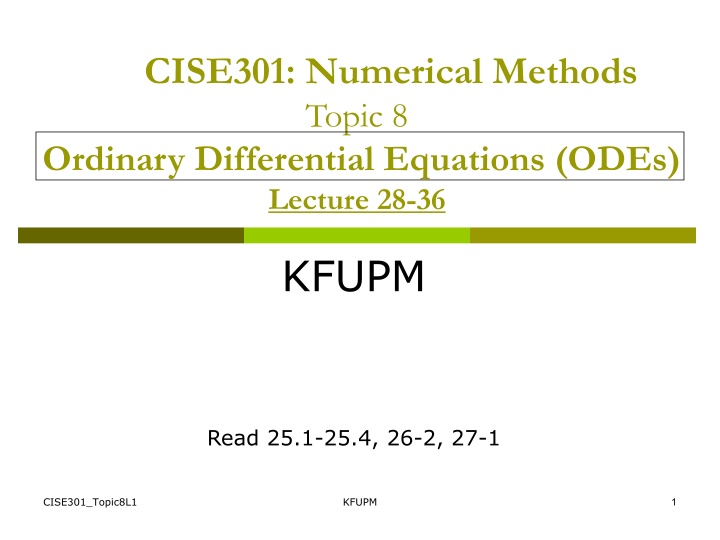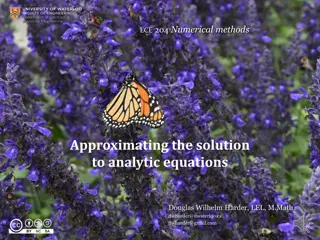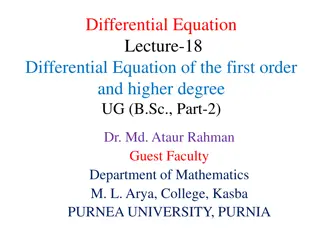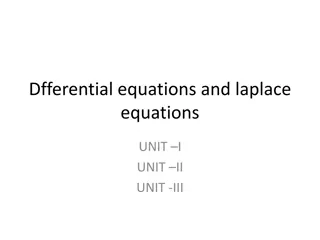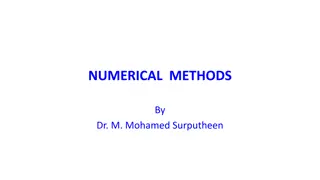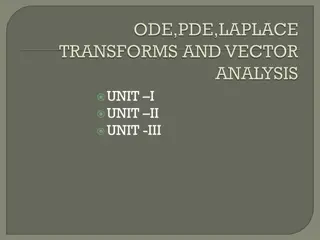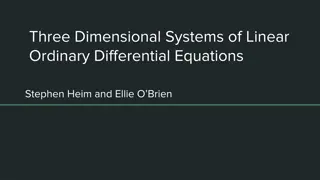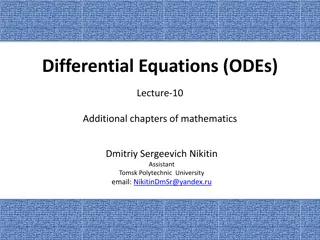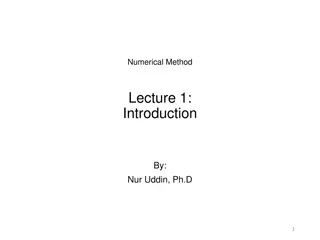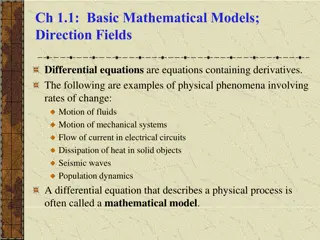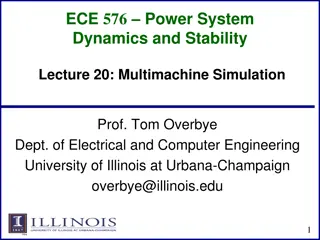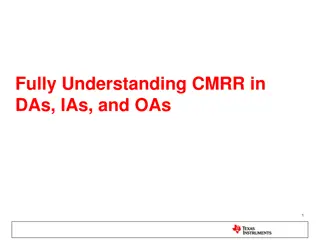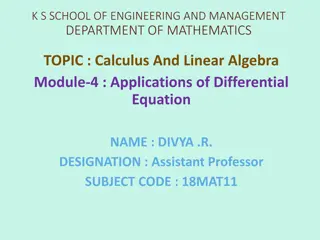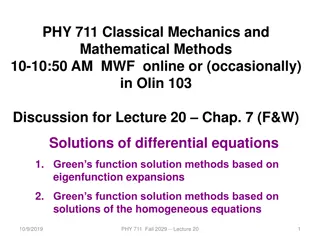Ordinary Differential Equations in Numerical Methods
Delve into the world of Ordinary Differential Equations (ODEs) in numerical methods. Explore how to solve ODEs, assess different techniques' reliability, and choose the right method for various problems. Topics include ODE definitions, order, linearity, solution methods, derivatives, and differential equations. Enhance your knowledge and skills in ODE problem-solving.
Download Presentation

Please find below an Image/Link to download the presentation.
The content on the website is provided AS IS for your information and personal use only. It may not be sold, licensed, or shared on other websites without obtaining consent from the author.If you encounter any issues during the download, it is possible that the publisher has removed the file from their server.
You are allowed to download the files provided on this website for personal or commercial use, subject to the condition that they are used lawfully. All files are the property of their respective owners.
The content on the website is provided AS IS for your information and personal use only. It may not be sold, licensed, or shared on other websites without obtaining consent from the author.
E N D
Presentation Transcript
CISE301: Numerical Methods Topic 8 Ordinary Differential Equations (ODEs) Lecture 28-36 KFUPM Read 25.1-25.4, 26-2, 27-1 CISE301_Topic8L1 KFUPM 1
Objectives of Topic 8 Solve Ordinary Differential Equations (ODEs). Appreciate the importance of numerical methods in solving ODEs. Assess the reliability of the different techniques. Select the appropriate method for any particular problem. CISE301_Topic8L1 KFUPM 2
Outline of Topic 8 Lesson 1: Lesson 2: Lesson 3: Lessons 4-5: Runge-Kutta methods Lesson 6: Solving systems of ODEs Lesson 7: Multiple step Methods Lesson 8-9: Boundary value Problems Introduction to ODEs Taylor series methods Midpoint and Heun s method CISE301_Topic8L1 KFUPM 3
Lecture 28 Lesson 1: Introduction to ODEs CISE301_Topic8L1 KFUPM 4
Learning Objectives of Lesson 1 Recall basic definitions of ODEs: Order Linearity Initial conditions Solution Classify ODEs based on: Order, linearity, and conditions. Classify the solution methods. CISE301_Topic8L1 KFUPM 5
Derivatives Derivatives Partial Derivatives u Ordinary Derivatives dv y dt u is a function of more than one independent variable v is a function of one independent variable CISE301_Topic8L1 KFUPM 6
Differential Equations Differential Equations Ordinary Differential Equations 2 + tv dt Partial Differential Equations 2 2 x y u u d v = = 0 6 1 2 2 2 involve one or more involve one or more partial derivatives of unknown functions Ordinary derivatives of unknown functions CISE301_Topic8L1 KFUPM 7
Ordinary Differential Equations Ordinary Differential Equations (ODEs) involve one or more ordinary derivatives of unknown functions with respect to one independent variable : Examples ( ) dv t = t ( ) v t e x(t): unknown function dt 2 ( 2 ) ( ) d x t dx t + = 5 2 ( ) cos( ) x t t dt dt t: independent variable CISE301_Topic8L1 KFUPM 8
Example of ODE: Model of Falling Parachutist The velocity of a falling parachutist is given by: d v c 8 . 9 = v d t M : M mass : c drag coefficien t : v velocity CISE301_Topic8L1 KFUPM 9
Definitions Ordinary differential equation dv c = 8 . 9 v dt M CISE301_Topic8L1 KFUPM 10
Definitions (Cont.) d v c = 8 . 9 v (Dependent variable) unknown function to be determined d t M CISE301_Topic8L1 KFUPM 11
Definitions (Cont.) d v c = 8 . 9 v d t M (independent variable) the variable with respect to which other variables are differentiated CISE301_Topic8L1 KFUPM 12
Order of a Differential Equation The order of an ordinary differential equations is the order of the highest order derivative. : Examples ( ) dx t = t ( ) x t e First order ODE dt 2 ( 2 ) ( ) d x t dx t + = 5 2 ( ) cos( ) x t t Second order ODE dt dt 3 2 ( 2 ) ( ) d x t dx t Second order ODE + = 4 2 ( ) 1 x t dt dt CISE301_Topic8L1 KFUPM 13
Solution of a Differential Equation A solution to a differential equation is a function that satisfies the equation. : t dx Example = t ( ) Solution x t e ( ) + = ( ) 0 x t Proof dx : dt ( ) t = t e dt ( ) dx t + = + = t t ( ) 0 x t e e dt CISE301_Topic8L1 KFUPM 14
Linear ODE An ODE is linear if The unknown function and its derivatives appear to power one No product of the unknown function and/or its derivatives : Examples ( ) dx t = t ( ) x t e Linear ODE dt 2 ( 2 ) ( ) d x t dx t + = Linear ODE 2 5 2 ( ) cos( ) t x t t dt dt 3 2 Non-linear ODE ( 2 ) ( ) d x t dx t + = ( ) 1 x t dt dt CISE301_Topic8L1 KFUPM 15
Nonlinear ODE An ODE is linear if The unknown function and its derivatives appear to power one No product of the unknown function and/or its derivatives Examples t dx of nonlinear ODE : ( ) = cos( ( )) 1 x t dt 2 ( 2 ) ( ) d x t dx t = 5 ( ) 2 x t dt dt 2 ( 2 ) ( ) d x t dx t + = ( ) 1 x t dt dt CISE301_Topic8L1 KFUPM 16
Solutions of Ordinary Differential Equations ) 2 cos( ) ( = t t x solution a is to the ODE 2 ( 2 ) d x t + = 4 ( ) 0 x t dt Is it unique? functions All = + of the form ( ) cos( 2 ) x t t c (where a is c constant) real solutions. are CISE301_Topic8L1 KFUPM 17
Uniqueness of a Solution In order to uniquely specify a solution to an nth order differential equation we need n conditions. 2 ( ) d y x dx y y + = 4 ( ) y x 0 Second order ODE 2 = = (0) (0) a b Two conditions are needed to uniquely specify the solution CISE301_Topic8L1 KFUPM 18
Auxiliary Conditions Auxiliary Conditions Boundary Conditions Initial Conditions The conditions are not at one point of the independent variable All conditions are at one point of the independent variable CISE301_Topic8L1 KFUPM 19
Boundary-Value and Initial value Problems Boundary-Value Problems Initial-Value Problems The auxiliary conditions are not at one point of the independent variable More difficult to solve than initial value problems The auxiliary conditions are at one point of the independent variable + + = 2 t 2 x x x e + + = 2 t 2 x x x e = 5 . 1 = ) 0 ( x , 1 ) 2 ( x = = ) 0 ( x , 1 ) 0 ( x 5 . 2 same different CISE301_Topic8L1 KFUPM 20
Classification of ODEs ODEs can be classified in different ways: Order First order ODE Second order ODE Nth order ODE Linearity Linear ODE Nonlinear ODE Auxiliary conditions Initial value problems Boundary value problems CISE301_Topic8L1 KFUPM 21
Analytical Solutions Analytical Solutions to ODEs are available for linear ODEs and special classes of nonlinear differential equations. CISE301_Topic8L1 KFUPM 22
Numerical Solutions Numerical methods are used to obtain a graph or a table of the unknown function. Most of the Numerical methods used to solve ODEs are based directly (or indirectly) on the truncated Taylor series expansion. CISE301_Topic8L1 KFUPM 23
Classification of the Methods Numerical Methods for Solving ODE Single-Step Methods Estimates of the solution at a particular step are entirely based on information on the previous step Multiple-Step Methods Estimates of the solution at a particular step are based on information on more than one step CISE301_Topic8L1 KFUPM 24
